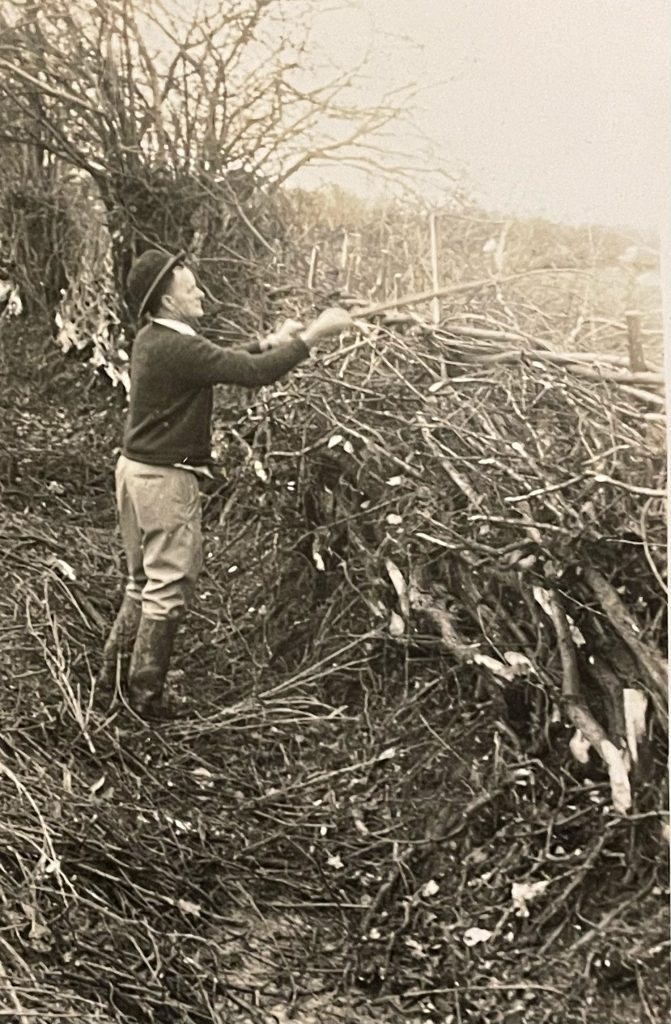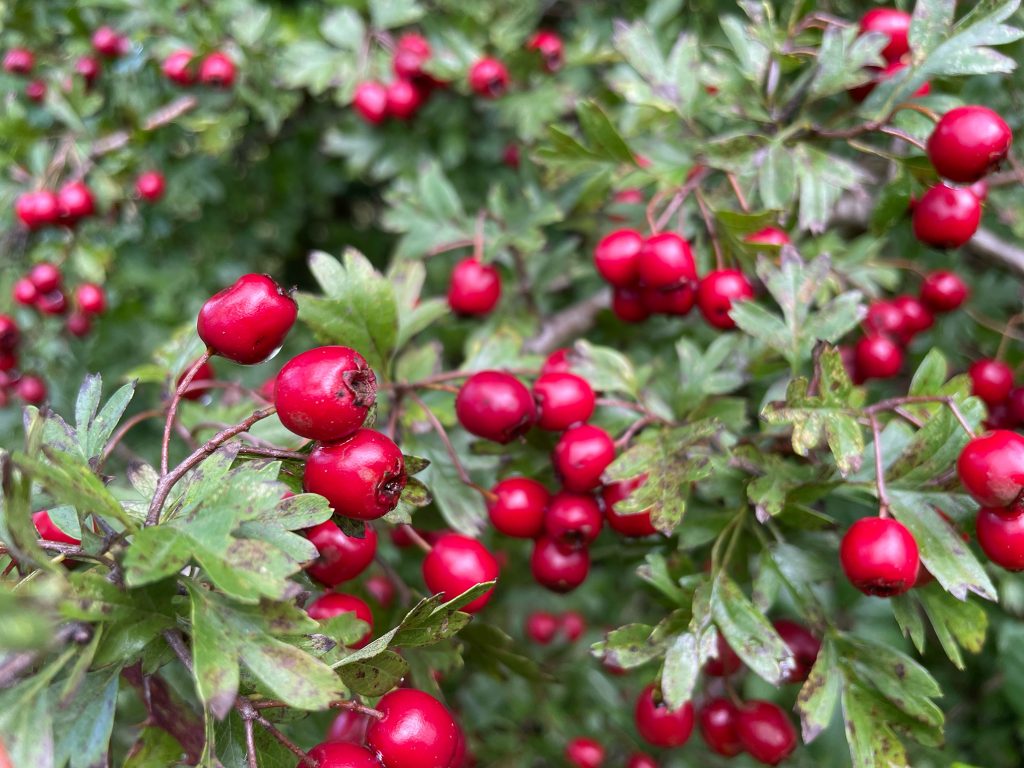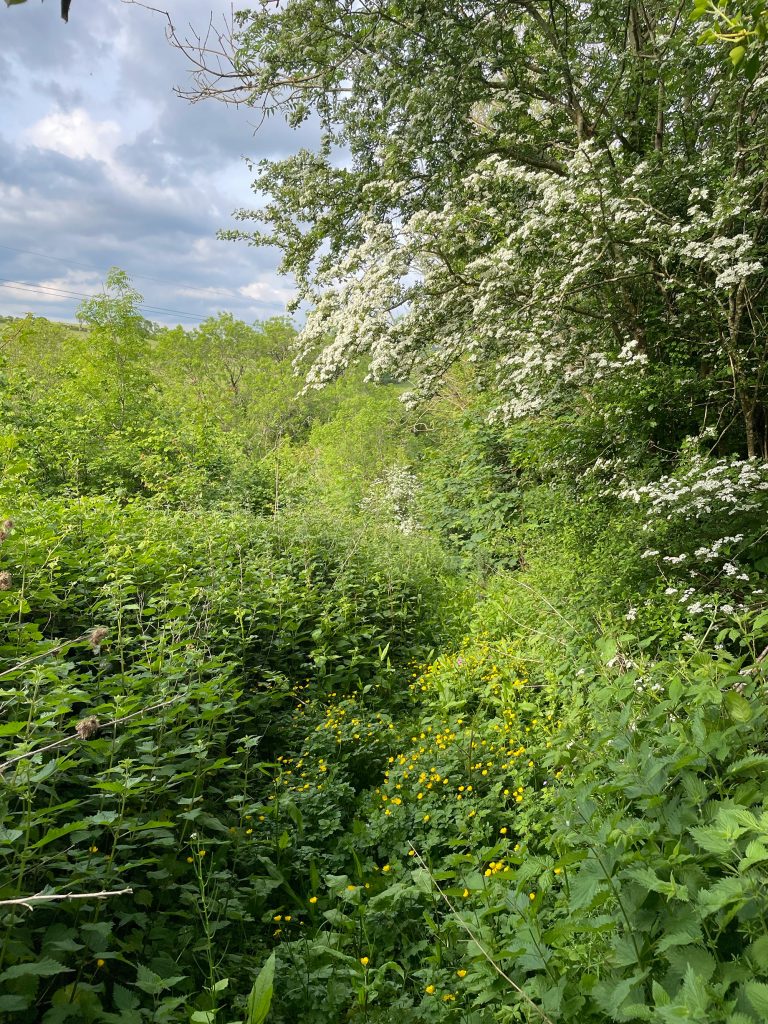The recent dry spell has been much appreciated, but the colder weather has turned my thoughts to birds. Bird numbers have been challenged over the last few decades, and they need our help.
Feeding birds with bird feeders has become very popular. It is a great pleasure to see birds congregating outside the window. However bird feeding stations are not without their downsides; they can spread disease between birds, and are always going to be a temporary measure. When we are not around to fill the feeders, then the birds go hungry. And although I (sometimes) like the idea of immortality, we are not going to be around forever. There is however a solution that will offer habitat and food to birds indefinitely. That solution: plant hedges.
Hedge laying of the past

This family photo from the 1920s shows a worker laying hedges on my great-grandfather’s farm. Over the winter his team would cover a third of the total hedges, meaning that each hedge would only receive attention once every three years. The bushy growth that followed would have been excellent for wildlife. At that time everything was done by hand using bill hooks and secateurs.
After the war the government demanded that a greater quantity of land was set aside for cultivation, and land previously unsuited for growing was put to use. This then required the development of artificial fertilisers. Tractors started arriving from across the Atlantic, thus reducing the need to grow food for horses. Farm machinery grew bigger. As a child growing up in the 1970s I watched hedges being pulled up to increase field size. Now the few existing farm hedges we have left are scalped at the end of the summer by hedge trimmers.
I must make it clear that it is not the fault of farmers that the countryside has lost so much of its diversity; I suspect it would have been impossible to make a living without changing farm practice to fit with the policies of the time. There has long been a conflict between producing food and allowing space for wildlife, and food production has been prioritised by successive governments for over eighty years.
However as individuals we can help. It is hedge planting time and it’s also time for my annual plea for readers of this column to plant hedges. Until the end of March it is possible to buy cheap bare-rooted hedging plants. (A quick internet search will yield a plethora of choices. We’ve used Perrie Hale nurseries and Best4hedging in the past, and both have been good). At this time of year trees are dormant, and getting them into the ground before they begin to stir and put out leaves is the key to hedging success.

The best sort of wildlife hedges are allowed to flail their hair in an exuberant fashion, bushy and wild. However even a small garden can support a modest hedge. I thought it would be helpful in this article to explain the different choices of hedging plants.
Different types of hedging
To begin your hedge you usually start with a base species, that makes up the majority of the hedging whips. This is usually hawthorn or blackthorn. These are cheap saplings that will bush out and provide a nice dense background to the other plants. My advice; while blackthorn is valuable on the edges of woods and shrubby land, hawthorn is best in a garden. Blackthorn suckers, and their sharp thorns have a quality that causes scratches to become septic. Hawthorns will give lovely white blossom, a little later than blackthorn, which is followed by clusters of red haws.
Adding to your base plant there are a number of good choices to consider. Field maple has spring blossom that is much loved by bees and offers beautiful autumn colours. Crab apple for blossom and fruit. Guelder rose has pollinator friendly flowers and bright red autumn berries. Damson and bird cherry will add to a fruiting interest. Hazel is always welcomed by small mammals for its nuts. Dog rose will provide flowers and hips. If you want prickly, add pyracantha, holly and berberis to your mix, all of which are good for berries and pollinator friendly flowers.
After planting your hedge, pruning it hard in the first few years will encourage it to grow bushy. Once your hedge is established, then encourage ivy to grow into it. Ivy is an excellent wildlife plant and can be encouraged to thicken the hedge for added shelter.
For the sake of birds and other wildlife, I would always recommend a native wildlife hedge. However any hedge is better than none. If you long for order, then privet, beech, robina, osmanthus, escallonia and cotoneaster all make neat hedges and offer some benefit. We’ve found stick insects and seen blackbirds sheltering in leylandii. However any monoculture is unlikely to add the range of benefits a more mixed hedge will.
If you already have a hedge, then treasure it, protect it and let it grow as wild as you can. If you don’t, then do think about getting out a spade and planting one, even if it’s just a few metres long. It’s a great way of securing the future of the birds in your garden.

